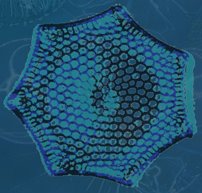Number of the Beast - Part 2: Layouts

Layouts for Number of the Beast #1, pages 6 & 7; click on the image to see an
extra large version
Last time I described how I create a thumbnail sketch for a typical comic book page and how I arrived at the final design for what became pages 6 & 7 of Number of the Beast #1. This time I'll be concentrating on the next step, the layouts. The layouts are the most difficult and work-intensive part of the entire process, at least for me. The layouts are where I work out the anatomical structure of all of the figures and hash out all the backgrounds.
For these two pages, I began by roughing out Engine Joe in the large panel running across the top of the spread using a blue pencil. Then I drew a perspective grid for the background behind Joe, which--among other things--allowed me to accurately place everything else in the panel. For example, since Joe is about ten feet tall, maybe higher, I knew that any doors in the background would be shorter than his shoulders, and that if I drew a fireplug or something in the foreground it would only come up to a certain height somewhere around his shins or his knees. Once the perspective grid was down on paper, I tightened up Engine Joe's figure, getting all of the details in the correct places and the parts in the correct proportions. I usually bear down pretty hard when I draw, so the linework gets dark fairly quickly, and that makes it hard to see the lines I've put down in some places. Since there were still parts of Joe's figure that needed fussing over, I went in with black lead and did some more finalizing, which you can see most clearly on his right arm in the image above. Once Joe was in good shape, I moved on and used the same process on The Aeronaut, the flying hero above Engine Joe, and then on to the homeless man in the foreground. Next, I worked on the background buildings, but as usual, I left the backgrounds fairly loose since I've drawn hundreds of street scenes and was confident I could do most of the work in the next step(the finished pencils). If the script had called for a more complicated background, a recognizable building or something I've never drawn before, I would have been more precise here in the layouts. Once this large panel was done, I went through the entire process again for each of the remaining panels. As soon as I finished the layouts I knew this spread was going to work well. I couldn't wait to get to work on the finished pencils...which is part 3, and I'll cover that next time!
Tools/materials used in this step:
- 11"X17" copy/office paper
- PaperMate PRO-Touch II mechanical pencil w/Pentel 0.9mm blue lead
- Alvin Draftmatic mechanical pencil w/Pentel 0.9mm red lead
- PaperMate PRO-Touch II mechanical pencil w/Pentel 0.7mm H black lead
--C


2 comments:
I remember Eddie Campbell talking a lot about really putting the emphasis on balloon placement and flow in the thumbnail stages of his work, even to the point where he starts with a blank page and writes the dialogue in balloons first.
It's interesting to see a different perspective. How much is the dialogue on a page like this effecting the way you're laying it out?
The order of the balloons determines pretty much everything about where the characters have to be in any given panel. Sometimes I think I should draw in all the balloons when I'm doing layouts, but mostly I worry about the lettering in the thumbnail stage, when I'm deciding where to place everybody and how to stage scenes. After that, I just keep a copy of the script on hand to refer to. Every once in a while I just underestimate how much room a balloon or series of balloons will require, but not very often anymore.
Post a Comment